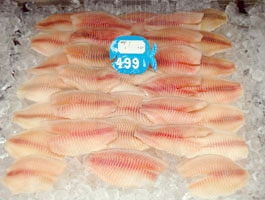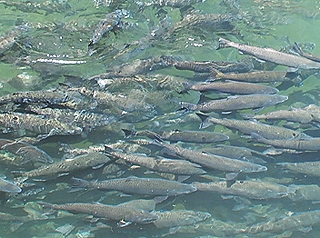Posts Tagged: aquaculture
Fishing for aquaculture answers
If you buy fresh fish with any regularity you’ve likely come across tilapia. A relative newcomer to American fish markets, the mild, flakey white fish originated in Africa and was introduced to American markets about 10 years ago, sometimes accompanied by favorable sustainability ratings from markets like Whole Foods. Most farmed tilapia consumed in the U.S. currently comes from fish farms in Central America.
“It's a fast-growing fish species that seems more sustainable because it is usually a plant-eater. That is, the fish can survive on plants rather than other fish,” says Alastair Iles, a UC Berkeley assistant professor of environmental science, policy, and management, whose policy research includes studying aquaculture and in particular farmed tilapia.
But sustainability turns out to be a slippery term. “Producing tilapia brings into play a wide range of issues — how developing countries are trying to create sustainable tilapia farming systems but are also struggling with the pollution and waste that they produce,” Iles says.
The scale of the aquaculture industry is expanding around the world, generating, Iles says, a number of environmental and social impacts that cause increasing concern. In addition to the waste problem that fish farms create, feed made from other fish can deplete fisheries even more, and making soy feed may involve land-based agriculture, which could lead to deforestation in countries like Brazil. Escapes of farmed fishes into the wild harm the genetic diversity of the wild tilapia, and there are land use effects as well. As a result, multiple certification schemes are emerging to try to define "sustainable" aquaculture at the global scale.
“It's essential to look at how these schemes are developing because they may affect what the whole industry looks like in the future,” he says.
Iles and his collaborator Elizabeth Havice, an ESPM Ph.D. graduate who is now an assistant professor at the University of North Carolina, are examining two certification schemes that are currently developing: the Global Aquaculture Alliance, the aquaculture industry trade group; and the World Wildlife Fund, working in partnership with the newly formed Aquaculture Stewardship Council.
A new study by the Sustainable Fisheries Partnership, a non-governmental organization, compares the two schemes, and concludes that the WWF certification is tougher in its requirements than the GAA’s standard in that farmers tend to fail the WWF requirements more often. But there is little insight into why and how these differences occur. Is it because the two organizations are using science in different ways — for example, depending on a relatively narrow fish farm-centered impacts analysis, versus using a life-cycle approach that looks at where all the inputs comes from? Or is it because the negotiators of the schemes are aiming at technology-based standards that only large-scale farms can meet?
Iles and Havice focused on the WWF and GGA schemes as most important, examining how they have been developing their standards, which have different requirements. Like the Sustainable Fisheries Partnership study, the researchers are finding that the WWF standard is more likely to be sustainable than the GAA one.
“We think the World Wildlife Fund has paid much more attention to a participatory process and has heard from many more stakeholders, whereas the GAA has been quite top-down,” Iles says. They plan to publish their findings next year.
For now, what’s an environmentally sensitive consumer to do? Avoid farmed fish like tilapia? Iles says that’s not the answer. “We need aquaculture for the foreseeable future because wild-caught fisheries just can't supply enough fish,” he says.
But he stresses that there are very different ways to practice this aquaculture. The new standards, together with Iles’ research to clarify the science behind them, should help navigate the murky waters.
“Our aim is to help improve the science-based process for developing these standards so that aquaculture can evolve into the most genuinely sustainable forms and will actually change how farmers across the world practice their work,” he says.
In the meantime, Iles recommends that if you are buying farmed fish, ask for certification to help ensure that the fish is more sustainable. The new certifications are just beginning to show up in stores, so, watch for them, and demand from your store that they be used.
Bleak future for spring-run Chinook salmon
Warming streams could spell the end of spring-run Chinook salmon in California by the end of the century, according to a study by scientists at UC Davis, the Stockholm Environment Institute (SEI) and the National Center for Atmospheric Research (NCAR).
There are options for managing water resources to protect the salmon runs, although they would impact hydroelectric power generation, said UC Cooperative Extension associate specialist Lisa Thompson, director of the Center for Aquatic Biology and Aquaculture at UC Davis. A paper describing the study was published online recently in the Journal of Water Resources Planning and Management.
“There are things that we can do so that we have the water we need and also have something left for the fish,” Thompson said.
Working with Marisa Escobar and David Purkey at SEI's Davis office, Thompson and colleagues at UC Davis used a model of the Butte Creek watershed, taking into account the dams and hydropower installations along the river, combined with a model of the salmon population, to test the effect of different water management strategies on the fish. They fed in scenarios for climate change out to 2099 from models developed by David Yates at NCAR in Boulder, Colo.
In almost all scenarios, the fish died out because streams became too warm for adults to survive the summer to spawn in the fall.
The only option that preserved salmon populations, at least for a few decades, was to reduce diversions for hydropower generation at the warmest time of the year.
“If we leave the water in the stream at key times of the year, the stream stays cooler and fish can make it through to the fall,” Thompson said.
Summer, of course, is also peak season for energy demand in California. But Thompson noted that it might be possible to generate more power upstream while holding water for salmon at other locations.
Hydropower is often part of renewable energy portfolios designed to reduce greenhouse gas emissions, Purkey said, but it can complicate efforts to adapt water management regimes to a warming world. Yet it need not be all-or-nothing, he said.
“The goal should be to identify regulatory regimes which meet ecosystem objectives with minimal impact on hydropower production,” he said. “The kind of work we did in Butte Creek is essential to seeking these outcomes.”
There are also other options that are yet to be fully tested, Thompson said, such as storing cold water upstream and dumping it into the river during a heat wave. That would both help fish and create a surge of hydropower.
Salmon are already under stress from multiple causes, including pollution, and introduced predators and competitors, Thompson said. Even if those problems were solved, temperature alone would finish off the salmon — but that problem can be fixed, she said.
“I swim with these fish, they're magnificent,” Thompson said. “We don't want to give up on them.”
Other co-authors of the paper are graduate student Christopher Mosser and Professor Peter Moyle, both in the Department of Wildlife, Fish and Conservation Biology at UC Davis. The study was funded by the U.S. Environmental Protection Agency.



